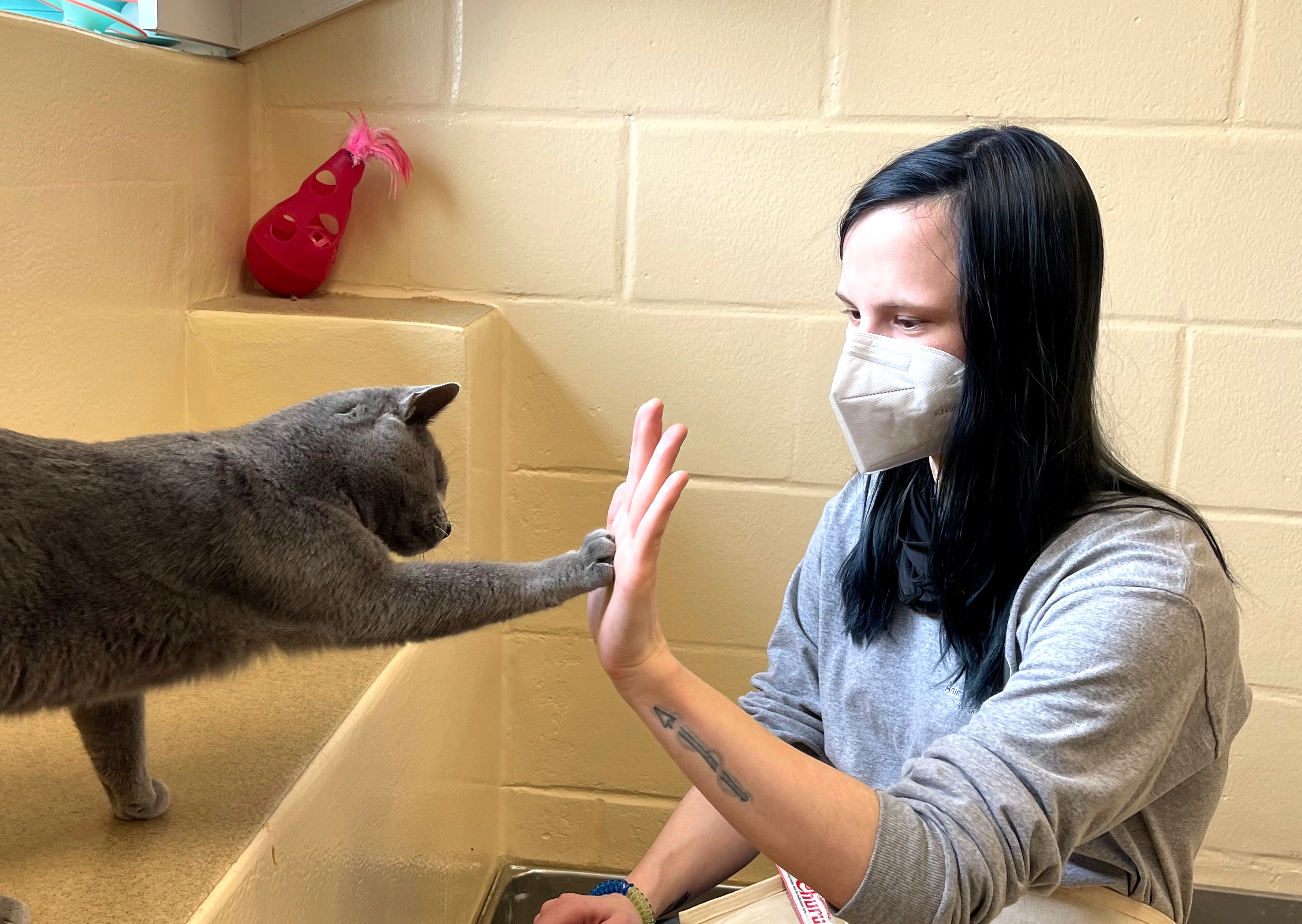
Changing Behavior: Why Punishment Does Not Work
Spray bottles, shouts, shock mats collars, smacks to the nose, the rubbing of noses in urine…so many means of punishment, and in my experience consulting clients, they tend to be used more often than not. Most people I speak to reference using a spray bottle to "train" their cats, and no matter how many times I hear it, it still shocks me every time. The research is there, and has been for some time: what’s known as “Positive punishment” or aversive training, is minimally effective and in many cases even detrimental, so why does this continue? Why aren’t guardians taught other methods? We’re falling short somewhere. Outdated and harmful methods are perpetuated and the behavior calls keep flooding in. As a secondary issue, I see that even those that understand the rights and wrongs in behavior modification often misrepresent or misunderstand the four quadrants of operant conditioning – calling positive punishment negative reinforcement is a rampant problem and is actually pretty serious. Even fellow behaviorists are doing it! We need to be clear and concise, communicate things properly. Today we’re going to discuss why punishment isn’t effective, why it can be harmful, some data on human perceptions, and the alternatives. Today, you will learn some behavior science.
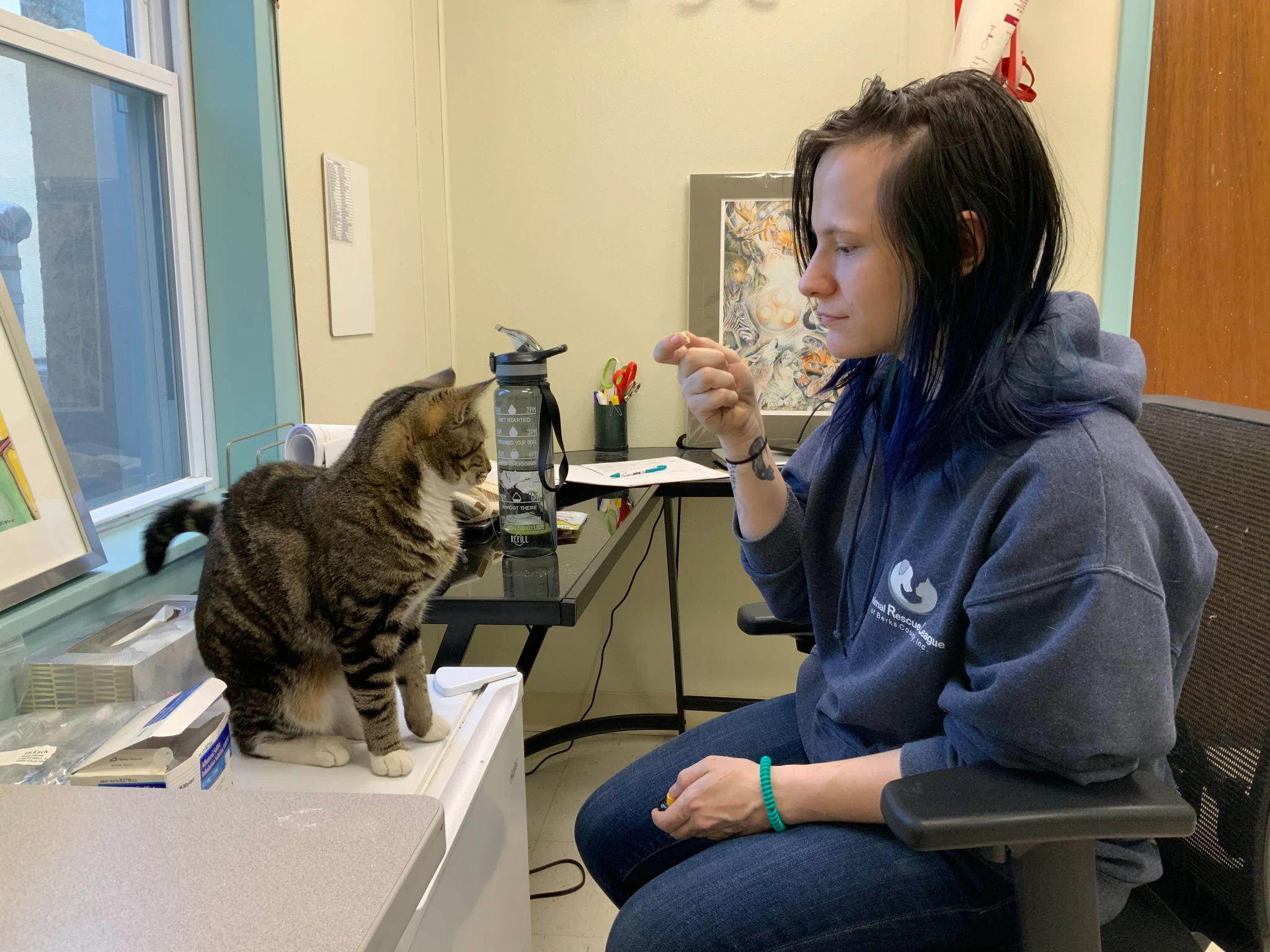
Training Abigail to sit
The most common argument in defense of punishment as behavior modification, we'll use spray bottles here, is something along the lines of: “I’ve used spray bottles on all of my cats and they’ve never been afraid of me!” or “Every time I touch the spray bottle, my cat goes running…so it works!” There are issues with both forms, so let's unpack shall we?
In the first, sure, I’m happy for you. But are you willing to continue taking such a risk? This can turn out very badly. All it takes is one crossed wire moment of sensitivity or anxiety and you’ll have redirected aggression on your hands. Also…are you sure? Is there really no anxiety there? Do they know that spray bottle means no, not "Mom sprays me with the spray bottle"? Do they truly understand why they’re being sprayed? Have you been able to stop reaching for the spray bottle completely? For the second, of course the cat runs, it’s scary. If your parent grabbed a belt and came for you, you’d probably run, too! That's just the way it works. My question is, is it stopping the unwanted behavior, the approach, the desire? The answer is no. You’re still having to reach for it. It hasn’t trained them anything other than that the spray bottle, and consequently, you, are scary. They know nothing of their behavior, only of yours. "Mom’s reaching for that thing again, she’s going to spray me, I’d better go. I hate when she’s like this!" Your experience doesn’t invalidate the studies: we have data on this. Anecdote can be valuable, but not when it's entirely contrary. Even if it wasn't, if you know that something is potentially causing fear, emotional or even physical pain or could cause further behavioral problems…wouldn’t you want to choose a more humane option? Especially if it’s proven to be more effective? Positive reinforcement is shown to work better and be, well, a positive experience for guardian and animal! Why would you need punishment? The only excuse to fight for it is laziness, a lack of care, being stuck in your ways and stubborn. That's it. Let's be better than that, yeah?
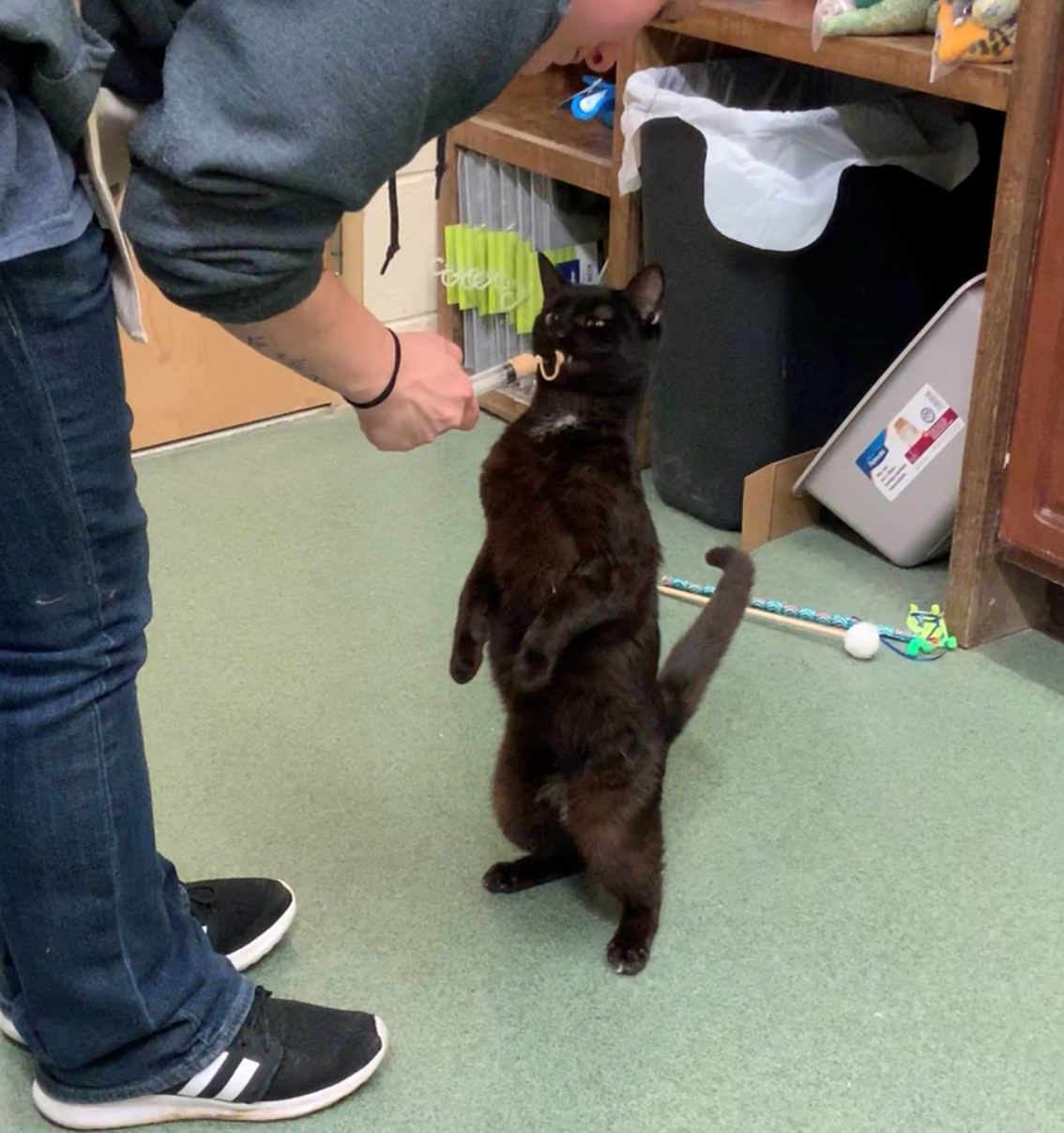
Training Cat 2 to stand – this one’s always made me giggle.
What are the forms of punishment?
Positive Punishment:
The act of adding stressful stimuli to decrease the occurrence of an undesired behavior. Example: Spraying the cat with water when it bites your ankles.
Remote aversives, such as a Sscat motion-activated compressed air can, are also positive punishment, but are more recommended than things such as the spray bottle as they do not require guardian involvement – it makes them safer (We still recommend them being a last resort, however as aversive training as a whole runs the risk of increasing anxiety, aggression, and problem behavior.) On the flip side, double-sided tape as a scratch deterrent is also positive punishment, and is also a remote deterrent/aversive. This is highly environmental and is minimally invasive/aversive. I have little issue recommending this one – as long as appropriate “yes” options have been provided! I’ll talk really negatively about punishment; but not all punishments are equal – the problem is, I see more people turning to or recommending highly aversive options and rarely see these environmental, minimally aversive ones. The concept of double-sided tape is so foreign and novel to people when I bring it up – they just thought they were supposed to yell at them or spray them! Their vet recommended the spray bottle, for goodness sakes! Tsk Tsk!
Negative Punishment:
The act of removing fun or otherwise positive stimuli to decrease the occurrence of behavior. Example: Removing your cats food if it vocalizes during feeding time. People practice this all the time with their kids, it’s grounding! “You didn’t do what I asked you to – I’m taking your phone away” etc. Cats don’t understand this one bit in most cases it would be applied. If they poop on their bed and you decide they can’t have beds anymore, you haven’t done anything to treat the inappropriate defecation, and the cat doesn’t understand why they don’t have comfy resting places anymore; you’re just a meanie, and they’re just sad and uncomfortable.
More appropriate methods: In the case of biters, use the non-response and leave method. They latch on, you go limp, and leave immediately. They’re not being rewarded for their action, they’re being punished because what they wanted was attention and play. They’re learning that biting doesn’t work out. This is somewhat effective in this instance because YOU specifically are the target. This should not be the sole method however. Come back after a few moments and play, positively reinforce appropriate play. This is how the cat will learn! “Good things happen when I play with this – nothing good happens when I try to wrestle with mom.” Negative punishment is superior to positive as the cat is learning that nothing good nor bad particularly happens, the good goes away, sure, but, nothing traumatic is happening. They’re just not being rewarded. When used appropriately, negative punishment can be okay but overall, the uses for it are very slim and it needs positive reinforcement or other therapies to be used in conjunction with it, as well as absolute consistency. If you do not leave every time you’re bitten, you’ve reinforced biting! That’s the thing about punishment. We’ll talk about that shortly.
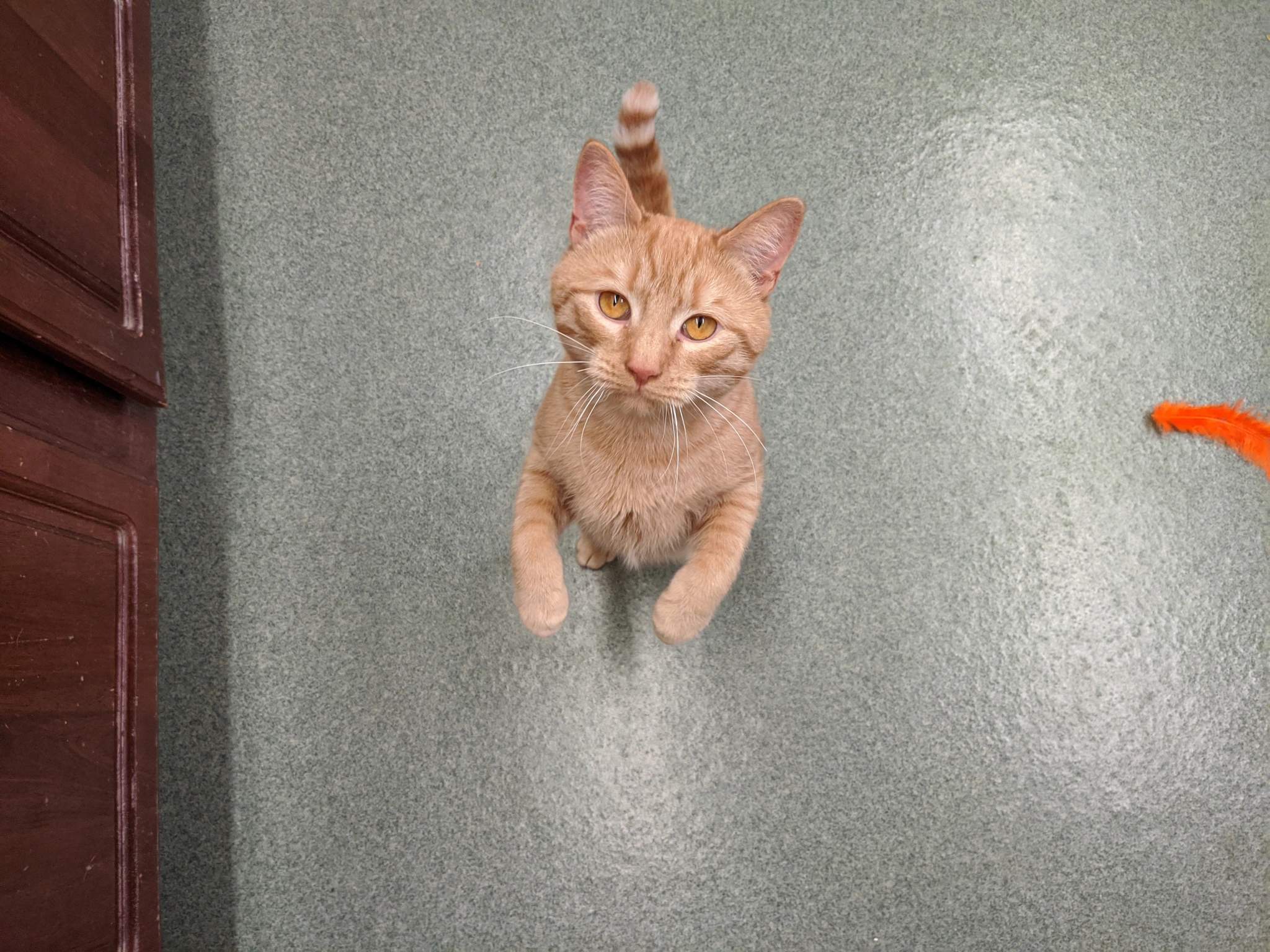
Larry was an expert at standing
Why doesn’t punishment work as well as other methods?
- 1. What may be punishment for one may not be punishment for another; nothing is absolute.
- 2. IPunishment requires absolute consistency; reinforcement does not. It’s been shown that in some species at least, intermittent reinforcement can actually work better than constant reinforcement. In punishment, constant is required, the lack of consistent punishment reinforces the behavior you’re trying to discourage.
- 3. When I say consistent – I should say constant. The animal will learn to perform the behavior in absense of punishment – or in absence of you, if you’re unable to punish at certain times. Say, you’re trying to train the cat not to be on furniture, but you’re not home for 8 hours a day. It’s been found that these animals do, indeed lounge on the furniture when their guardians aren’t home. Why wouldn’t they? The threat is gone. They don’t know that being on the furniture is the problem, the punishment is the problem – because it’s not perfectly performed, therefore not understood!
- 4. Punishment has to be perfectly timed in order to be understood. With reinforcement there’s about a 3 second window for the cat to make the connection between behavior and consequence – although the sooner the better. Punishment, however, needs to be instantaneous for the cat to make the connection. If you’re not catching them in the act and applying punishment while they’re doing the undesired behavior, it’s useless and you’re just a scary maniac attacking the cat for no reason, in their mind. (Or, doing something super fun or weird and completely unrelated to the behavior – this is often the case with time outs. Heard the cat scratching something they weren’t supposed to, run to get the cat – they’re already done scratching – carrying it to a room, the cat loves this! Attention! – lock it in a room..cat doesn’t get it, probably yowling…”why am I in prison?? Mother?” and then is let back out with no idea why what just happened happened – a little stressed and excited, ready to scratch up that couch again to relieve stress!) To effectively punish scratching behavior, she’d need to (and I’m not recommending this, at all) come around the corner WHILE the cat was scratching the couch and hit it’s back legs with the spray bottle, scaring it, and hope the cat didn’t associate the fear with any of the people or animals in the room – instead, with the act of scratching the couch. She would then have to stake out and make sure she was able to repeat that Every. Single. Time. The cat scratched the couch. No mistakes. Not too early, not too late, and never missing a scratch. It’s not feasible.
- 5. Punishment builds adversarial relationships between guardian and animal. It is coercion, violence, fear-building. So, studies have shown that bonds between guardians and animals in homes where positive punishment is used do not have weaker bonds – but their opinions are widely different (seeing cats as aloof, fearful, aggressive), knowledge is far lower, and behavioral problems are more prominent. Punishment is shown, overall, and especially in dog studies, to increase aggression – because it is aggression. Respond like with like! It creates negative feelings, of course it does. Even if it’s only temporary, why would you want to? Over extended time – especially if this training isn’t effective, these feelings can generalize. Turning to fear, anxiety, or aggression towards the guardian. Do you want that? Do you really?
- 6. The risk of redirected aggression. In cats we use fear to punish more often than not, noisy, slippery tin foil, loud noises, sudden stimulus – if the cat isn’t aware of where it’s coming from or is particularly startled, they may associate the fear they experience with another source – a cat sibling that was passing by them, your toddler across the room, you – who is holding the spray bottle – and become aggressive towards that individual. In most cases, this can happen in a single episode – the cat being separated for a period of time to calm, and things go back to normal. But, if the cat is let out again, and frightened again in that same way, the risk of redirected aggression is heightened – and may generalize to…aggression towards that target. That cat may endlessly attack you, your toddler, its feline sibling, requiring more intensive reintroduction, therapy, medication, or in many instances, even rehoming. This is the damage of punishment by fear!
- 7. Possibility to develop other behavioral problems due to anxiety. So, we’ve generalized anxiety due to constant punishment of a specific behavior…now this cat has low confidence and high fear response…and they’ve started peeing outside of the box due to a lack of security in their territory. What’s wrong with the cat, right? Well, you – you caused this. This isn’t something you can just buy another box and fix now, this is a genuine psychological problem. This cat needs play therapy, maybe a medication like buspirone, it needs some positive reinforcement – and may even need to be trained back to the box! It’s been damaged. – Ever hear of C-PTSD in humans? Think of this like that. You should have made better parenting choices! Cats don’t have the tools to recover like we do.
- 8. You’re often punishing vital, natural behaviors, which is incredibly damaging. You yell at your cat for peeing outside of the box or spray it for scratching the couch. The cat doesn’t know that you’re punishing it for the location it did those things in. It knows that it just peed. It knows that it just scratched. And it knows both of those things just became very negative experiences. So now what? It could exacerbate the problem, or make it a medical one! A cat that won’t pee for fear of negative stimuli…UTI? Blockage? Self-soiling? That’ll be great! A cat that won’t scratch is a very anxious one. Ever met a smoker that was trying to quit? You might meet some teeth! You’ve eliminated stress relief, you’ve eliminated stretching, you’ve eliminated comfort. You could have instead redirected, but now they’re afraid of natural functions, and withdrawing.
Convinced yet? Listen, these big risks aren’t that common, the bottom line here is the lack of effectiveness, but the risks do mean something. With how extreme they arem do you want to take them? I’ve had to treat them, and it’s not fun for anyone! Taking the path of least harm should always be your goal, not just taking the most convenient route. Really, since it’s not effective, punishment isn’t even convenient! We’re just naturally inclined to do it and we need to retrain ourselves not to. With our pets, with our children…with each other. The world would be a better place. There’s a time and place where punishment is, in fact, appropriate…but we are way, way overzealous with it.
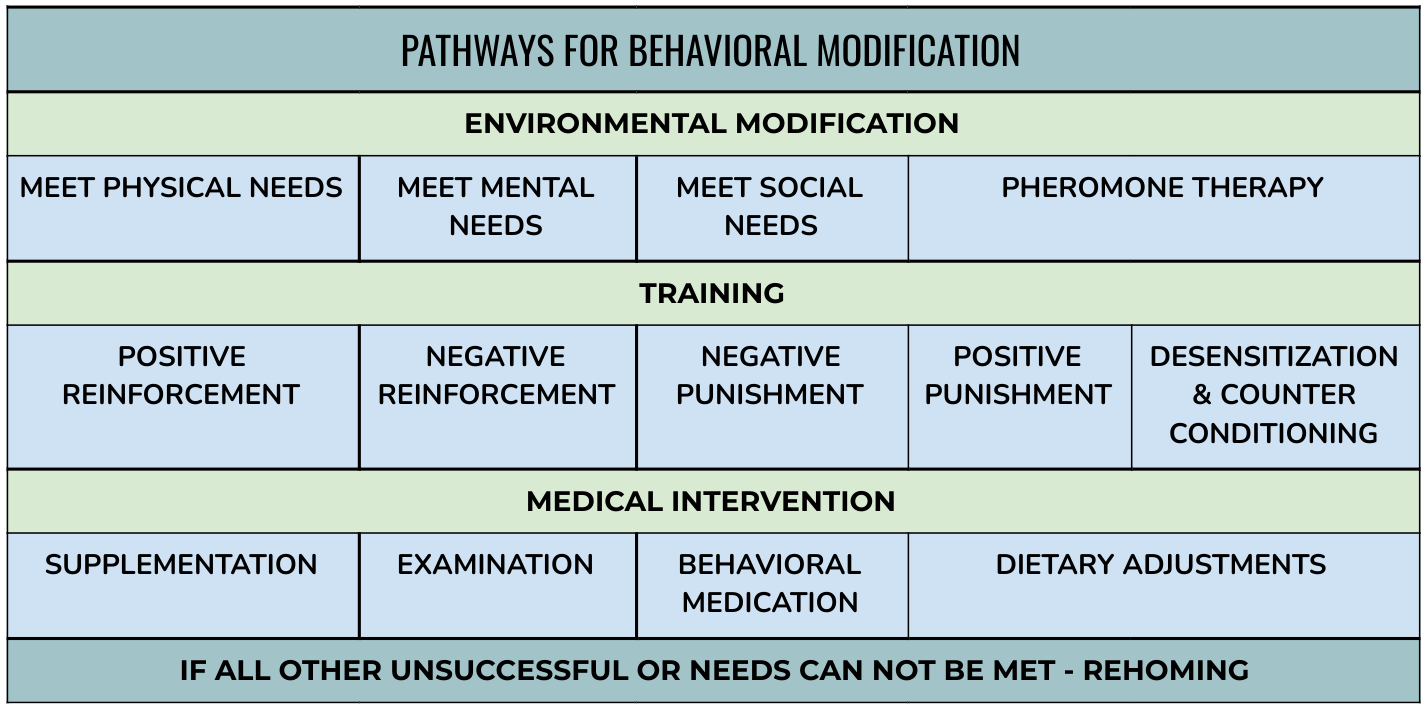
What do the studies say?
In a study performed on dogs, they were able to confirm that positive punishment aided in the development of negative behavioral traits. The highest aggression scores across the board in multiple studies, even in puppies, has been found in those who are trained using a combination of positive reinforcement and positive punishment – it’s hypothesized that this is due to a conflict in the dog due to inconsistency of responses by the guardian. They don’t know whether they can trust them or not – “will you hurt or scare me, or reward me?”
Across the board, punishment had higher scores of aggression, fear, and anxiety than any other method. The fear is typically with the guardian or the punishment itself, not with the behavior as it is intended – sometimes it is generalized. Positive reinforcement is associated across the board with lower attention-seeking and aggression scores, and fear scores – but did not necessarily have an effect on problem behavior control scores. Ultimately, the studies were able to confirm that more aggression comes from punishment, and that more problem behaviors occur.
In a study on cat owners it was found that most cats are only receiving the minimal in resources and enrichment (Tsk, tsk!)
It found a strong correlation with misconceptions about cats and high perceived costs of care with the use of positive punishment (Thinking cats are aloof, don’t like to play with people, are a solitary species, cannot be trained, pee out of the box for spite and generally misbehave, that medical care is too expensive…the study didn’t find that these people were any less attached to these cats, despite it sounding like they’re a burden to them!)
It found that more knowledge about cats correlated with less use of punishment, increased tolerance of misbehavior.
There was a direct correlation between the use of positive punishment and the amount of behavioral problems reported, as well as a direct correlation with owner knowledge and their use of punishment. Females tended to have higher knowledge scores, but age and duration of cat guardianship had no effect on knowledge.
Guardians with higher knowledge scores had significantly stronger bonds with their cats.
Low knowledge scores correlate with a higher instance of behavioral problems and higher use of punishment.
The more costly they thought the cats care to be, the more likely they were to punish their cat. (This one’s a little scary, really.)
12.3% of cats in this study had been declawed by their guardians – eliciting a further need for education.
Behavior problems were noted to be higher in those declawed cats (an additional 11.2% had been acquired already declawed) than their intact counterparts.
Unaltered (not spayed or neutered) cats had higher instance of behavioral problems.
There was no difference in behavioral problems between female and male cats.
90.3% of guardians reported that they try to redirect their cat.
85.2% of guardians reported that they use a loud noise to punish, such as clapping.
77% reported that they yell at their cat.
51.4% reported that they used spray bottles.
10.9% reported that they hit or kicked their cats.
2.2% reported their cats were on behavioral medication.
Ultimately the study concluded that we need to better educate cat guardians on cats – their needs, how to train them – to not use punishment, to not declaw. How to introduce them, providing ample resources and enrichment. It concluded that greater knowledge makes happier homes. Did we need a study to tell us that? I wouldn’t think so – but it seems we do, because so many are unwilling to learn!
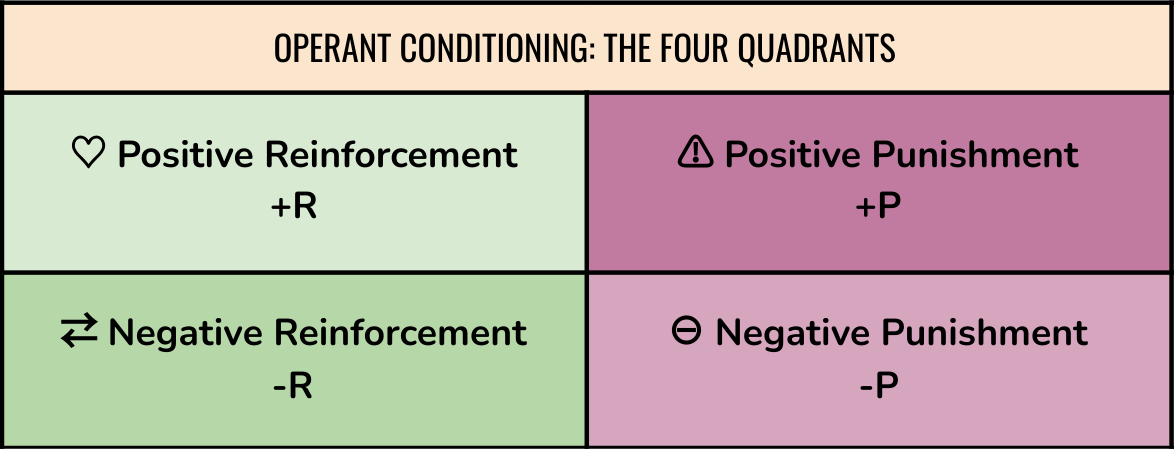
What can I do instead?
When we discuss positive and negative punishment, we’re discussing two quadrants of operant conditioning, there are four! The other two are Positive and Negative Reinforcement – which, happen to be the most effective training tools! Lucky for you, you’re able to implement them now. There’s classical conditioning, too – but that’s more passive learning, you don’t exactly “use” that – think of Pavlov’s dogs drooling every time they heard the bell ring, your cats running every time they hear a can pop – that’s classical. It’s just built associations. We do “use” that, in a sense, with clicker training, in that we apply the click to tell the cat they’ve completed the behavior and their treat is coming – and we apply the cue so that we can tell them what behavior it is, and request they perform it in the future – both are classical associations, but the actual training, in itself, is operant. Desensitization and counter-conditioning can be used – which are classical methods, a good example of this is, say your new cat is doing great, but is really afraid of the dog in the home, that’s the only barrier left to leaving the sanctuary room. Low intensity, you’d start by feeding the animals on opposite sides of the door – you’re desensitizing the cat to the dog’s scent, while performing counter-conditioning, building a positive association with the dog’s scent – dog’s scent = food. Food makes me happy! Next, maybe a baby gate. Two people, have one person interacting with the dog on one side of the gate, maybe at a distance (be sure sit and stay are trained) and another person in the room with the cat. Intermittently feed treats or provide affection while they see each other. Desensitization – they’re able to see each other without anything negative happening, stress should be decreasing. Counter conditioning – good things are happening when the dog is in sight. High intensity, the dog is brought into the room and made to sit on a lead, enjoying petting or treats, maybe a meal – the cat is on the opposite side, maybe playing, eating, or getting attention too. This is distinct from positive reinforcement as you’re not necessarily rewarding them for any specific behavior, you’re simply making an interaction positive to build an association. The cat IS learning to be calm around the dog, but you’re not really training a behavior or looking for any specific cues.
Positive Reinforcement:
The addition of positive, pleasant stimuli to increase the frequency of a desired behavior. Example: Giving a treat every time your cat uses their scratching post.
Negative Reinforcement:
The removal of a stressful or otherwise negative stimuli to increase the frequency of a desired behavior. My favorite way to use this is in the shelter setting with scaredy cats. A cat that’s very afraid of human presence, when presented with a new human might cower at the back of their kennel. When you approach, stand at a distance and wait, observing the cat in a non-threatening manner. When they show signs of calming in body language or otherwise, leave. The scary thing is gone, and they can now fully calm. What they don’t know is that they’re learning to be calm around you…and eventually may learn to like you! I always turn this into positive reinforcement as soon as the cat is willing to take food – tossing a test treat in before each session. Now, once a cat has been made fearful of a water bottle to the point of fleeing as soon as it sees one, you might say that you’re performing negative reinforcement by showing it one and then removing it to stop a behavior. But you’ve had to work up to this response with positive punishment, you caused trauma to now...just perform less. You haven't taught much, and you've created a stress response. This is not appropriate. It’s important to use negative reinforcement appropriately. This brings up the issue of it being improperly classified - you can't even look up ways to use it, because as far as the internet is concerned, this is positive punishment - the word negative has everyone confused, thinking it's their experience! Regardless, positive reinforcement is the preferred method and you shouldn’t be in many situations where you’ll need negative reinforcement, It’s just important to know of them all and use them appropriately – the methods, and the terms.
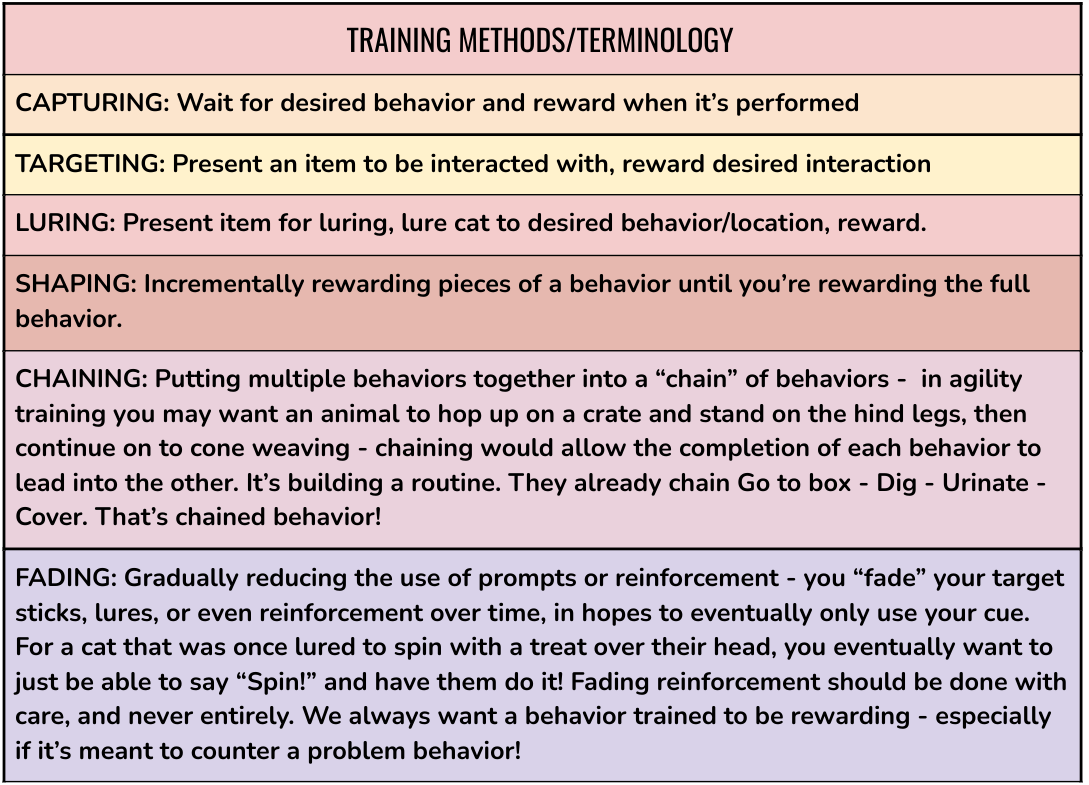
But how do I use positive reinforcement to change a behavior or make one stop?
This is the fun of it! Sometimes it’s super practical and obvious, sometimes it takes a bit of creativity, but the goal is to train incompatible behaviors and redirect. Overall, you might not even need positive reinforcement – before making that step, look at the environment. If the cat is inappropriately scratching, do you have enough resources, resources in preferred areas, orientations, or substrates, tall enough? Simply checking that could be enough. If not, you might just passively make the area reinforcing – add pheromone products, catnip, occasionally leave treats there, provide affection around there…they might redirect on their own! If that fails, it’s time for some hands-on work. With or without clicker, you’d positively reinforce the use of a scratching post. Any time the cat uses it, you’d reinforce! Simple as that. Luckily, with reinforcement, it’s fine that it’s intermittent, they won’t suffer any from not getting rewarded every single time – this is actually part of behavior science, there are many variable reward schedules in operant conditioning that can be, and are used. It’s been shown that some species even benefit more from intermittent schedules, but, I believe cats and dogs do seem to do best with more consistency. (I don’t have specific data for this, but have always been trained to always reinforce whenever possible, just not to sweat if I miss it!) If the cat will not use the scratching post, and that’s the issue – first make sure you’ve provided a variety – and then hold sessions rewarding the cat for interacting with them in specific ways to shape the behavior. Cat comes over and sniffs it when you’re sitting by it, reward – that’s the first two sessions. Cat steps on the base – next two sessions, wait for another behavior…maybe the cat experiments and gives it a little scratch – boom, you’re in. Reward that and wait for it again. Any little progression towards the behavior you want is rewardable, and this can happen within one session. If in the first session we progress from sniffing to standing on, go for it – but don’t take too many steps forward too fast. Shaping is like going up a flight of stairs, and it’s okay if they take a step back, too…you can always shape up again…so long as they’re not losing it all! Choose a point where they’re comfortably and consistently performing the behavior you’re looking for in that moment, then stop rewarding and wait for the next one…that’s all there is to it. Clickers help as the cat will know they’re in a session and when the clicking stops, they’ll know (Desired behavior) – (Lack of desired behavior) and may be more driven to experiment.
It’s worth noting here that you shouldn’t provide much attention in these sessions as it may be excess reward and delegitimize the training, or prove to be a distraction. Not too much talking, no petting unless that’s the reward (sometimes this can be hard to help, but, try and contain yourself!), et cetera. Again, a clicker can help avoid inadvertent reinforcement – as the click is what tells them “You did what I wanted” – it’s an extra safety.
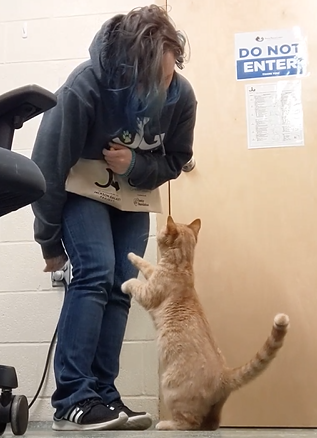
Larry in the process of learning his stand!
As another example, say you have a cat that won’t stop jumping on the counter when you’re preparing its wet food meal, just trying to steal some food early or lick the cans! Often we result to throwing them off the counter, yelling, just surrendering and letting them eat their stupid food on the counter, tossing the cans down to them – but we can actually work with this in a few different ways, I’ll go with stationing for this example! Provide a kitchen mat, chair cushion, cat bed, chair – anything the cat can sit on that you’re comfortable with in the kitchen. (Having sit trained already may help here, as well as having target training already down!) Lead the cat to the mat – or wait for them to approach the mat on their own. Depending on how they do, you might shape it a bit – if one foot touches it, reward, two feet, reward, four feet, reward, then sit. If they can be lured there and into a sit, it’s much faster. You’ll add a cue for going to this place – as soon as they’re all 4 on the floor there, or fully seated there, start saying the word! – Slowly moving it forward until you can say the word, and they do the thing. Once they’re sitting, you’d begin moving a bit – just a bit to start, and reward your cat for remaining seated. It may only be a few seconds at first, but, it will get longer! Start making larger movements, moving farther away, reward them for remaining seated. If you’ve moved too much and they don’t successfully stay, it’s alright, just get them seated again. You can work this duration up as long as you need to – and eventually even provide a cue for getting back up. You should, however, intermittently reward the stay (without click, if clicking) even after it’s trained to keep their attention…especially if doing this during feeding time, their desire for food might trump their interest in this weird game really fast. Once you feel comfortable that they’ve got this down, start testing it with the food out. It might not be an instant success – but, it does work.
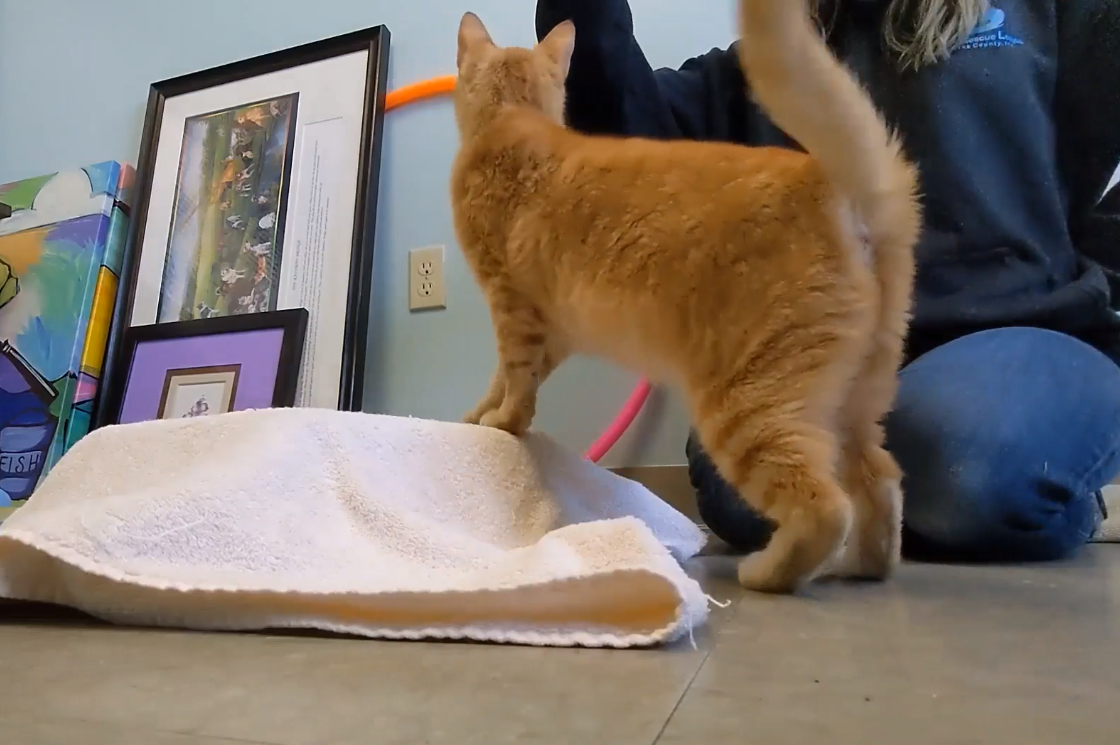
Betty learning to step up on a box as a step in stationing. She had a problem with biting feet as you walked around a room – she was easily overstimulated, so, I thought having her station in a specific area rather than underfoot where she would be overwhelmed by the movement would be helpful!
Those are just a few examples, but there’s so much more...the world of training is vast and wild. You saw me mention up there training a cat to use the litter box after it’s become aversive…yes, that can be done! Although…it comes with some wild side-effects! “Hey, ma, I know you’re sleeping, but…I gotta pee…come watch like you always do!” being one of them. But hey, might be better than pee on the floor!
I hope this post has taught you something. I feel it’s an incredibly important topic and I’ve been chomping at the bit to cover it! If anything, I’d hope punishment is no longer a word in your dictionary!
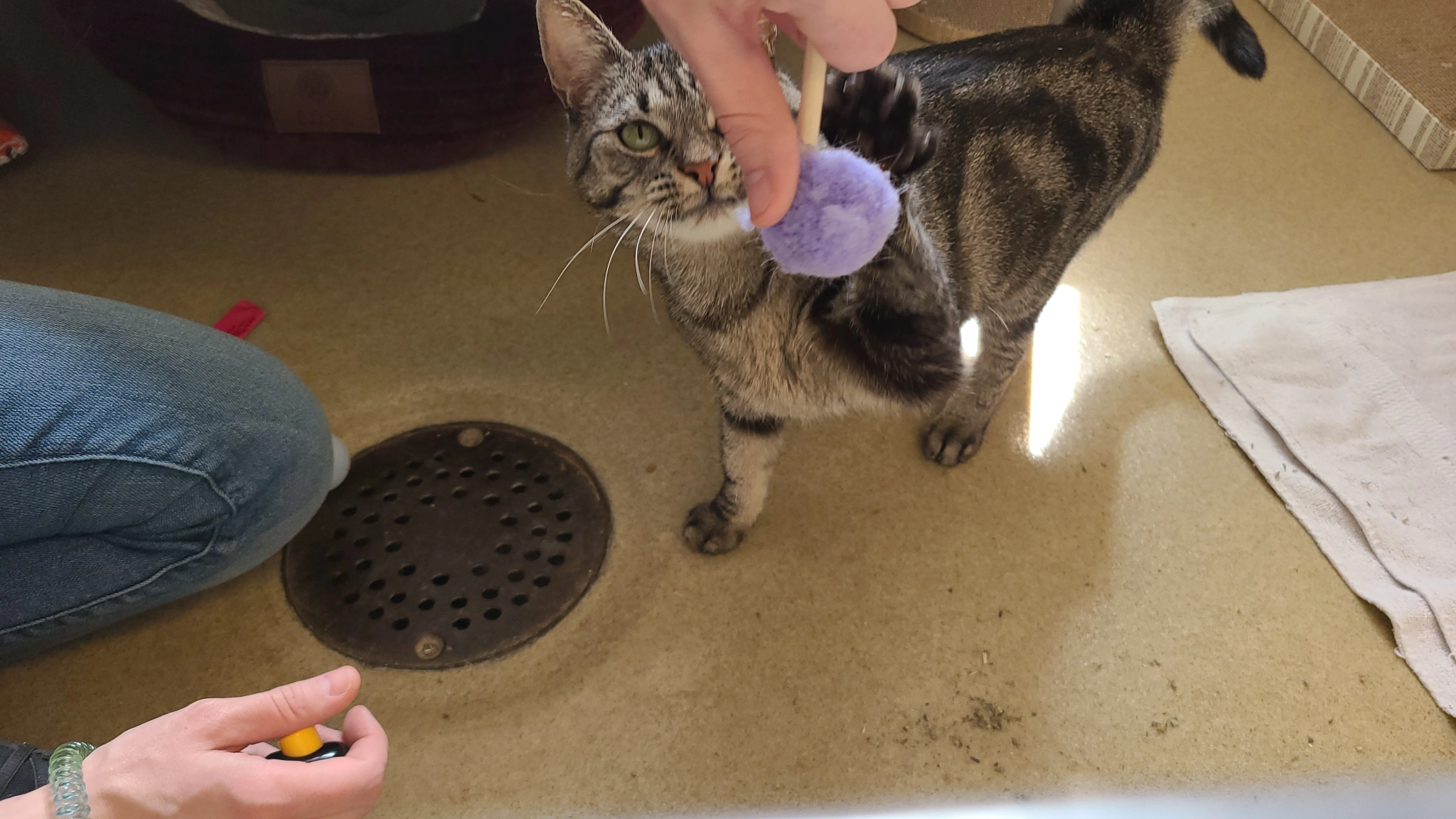
Torque learning high five – we’re shaping here, starting with a target because Torque was a little afraid of hands!
Until next time.
-Meg
